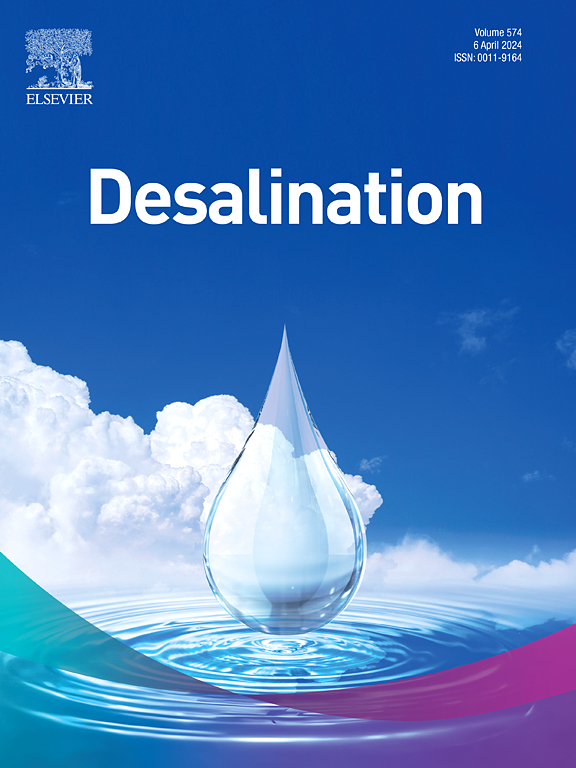膜表面和组件损坏对反渗透膜中病毒去除和完整性的影响
IF 9.8
1区 工程技术
Q1 ENGINEERING, CHEMICAL
引用次数: 0
摘要
反渗透膜组件在去除病毒和盐分方面非常有效,但其在全规模反渗透螺旋缠绕系统中的长期完整性仍令人担忧。膜的缺陷可能来自分层、氯或研磨颗粒的暴露,而模块的缺陷可能来自渗透管、O 形环和胶线的损坏。这些问题会损害膜和组件的性能,使传导性监测无法检测到的病毒得以通过。本文使用生物指标(天然病毒标记(NV))和非生物替代物(盐、硫酸盐、罗丹明 WT、吡喃)评估了损坏对病毒清除的影响。使用不同的解剖技术对三类组件损坏进行了研究和定性:膜组件部件损坏(渗透管损坏、O 型环损坏和膜脱层)、膜氧化损坏(次氯酸盐暴露剂量)和膜表面损坏(磨粒暴露)。模块组件损坏导致透水性增加,自然病毒排斥率降低。除渗透管损坏外,电导率仍与完好的组件相似。氯暴露(9000 ppm.h)不会导致在渗透水中检测到 NV 标记,这表明尽管活性层受损,但支撑层完好无损。进料中悬浮碳化硅的磨粒暴露导致了划痕(通过扫描电子显微镜图像观察到)和荧光标记剔除率的下降,这表明膜表面受损。结果表明,在因组件损坏而受到损害的组件中,NV 标记能最一致地确定病毒去除能力。然而,在评估活性层损伤时,罗丹明-WT 和吡喃等溶质被证明更为有效。这强调了采用多种指标全面评估膜完整性的必要性。本文章由计算机程序翻译,如有差异,请以英文原文为准。
Impact of membrane surface and module damage on virus removal and integrity in RO membranes
RO membrane modules are very effective in removing viruses and salts, but concerns remain regarding their long-term integrity in full-scale RO spiral wound systems. Membrane defects can arise from delamination, chlorine, or abrasive particle exposure, and module defects can arise from permeate tube, O-ring, and glue line damage. These issues compromise the membrane and module's performance, allowing viruses to pass that are not detected by conductivity monitoring. This paper assesses the impact of damage on virus removal using biological indicators (natural virus markers (NV)) and non-biological surrogates (salt, sulfate, rhodamine WT, pyranine). Three categories of module damage were studied and characterized using different autopsy techniques: membrane module component damage (permeate tube damage, O-ring damage, and membrane delamination), oxidative membrane damage (by hypochlorite exposure dose), and membrane surface damage (by abrasive particle exposure). Module component damage resulted in increased water permeability and decreased natural virus rejection. The conductivity remained similar to that of an intact module except in the case of permeate tube damage. Chlorine exposure (9000 ppm.h) didn't result in detectable NV markers in the permeate, indicating an intact support layer despite active layer damage. Abrasive particle exposure by suspended silicon carbide in the feed resulted in scratches, observed by SEM images, and a decline in the rejection of fluorescent marker, which indicates membrane surface damage. Results demonstrate that NV markers most consistently determine virus removal capacity in modules compromised by component damage. However, for assessing active layer damage, solutes like rhodamine-WT and pyranine prove more effective. This underscores the necessity of employing multiple indicators for a comprehensive evaluation of membrane integrity.
求助全文
通过发布文献求助,成功后即可免费获取论文全文。
去求助
来源期刊

Desalination
工程技术-工程:化工
CiteScore
14.60
自引率
20.20%
发文量
619
审稿时长
41 days
期刊介绍:
Desalination is a scholarly journal that focuses on the field of desalination materials, processes, and associated technologies. It encompasses a wide range of disciplines and aims to publish exceptional papers in this area.
The journal invites submissions that explicitly revolve around water desalting and its applications to various sources such as seawater, groundwater, and wastewater. It particularly encourages research on diverse desalination methods including thermal, membrane, sorption, and hybrid processes.
By providing a platform for innovative studies, Desalination aims to advance the understanding and development of desalination technologies, promoting sustainable solutions for water scarcity challenges.
 求助内容:
求助内容: 应助结果提醒方式:
应助结果提醒方式:


